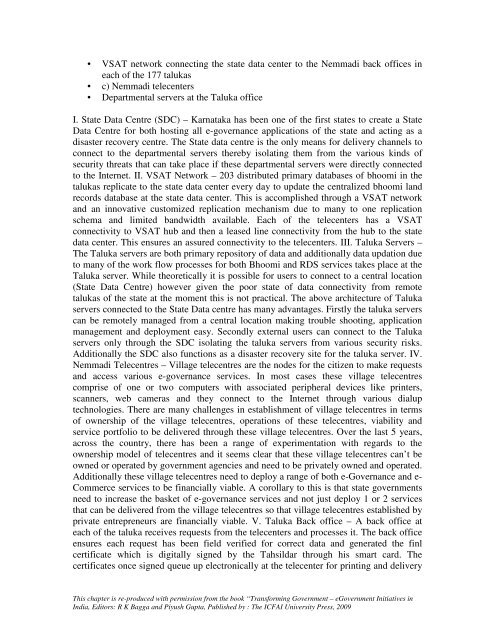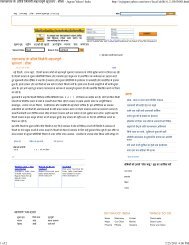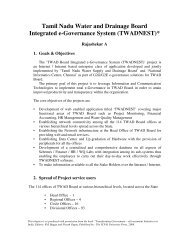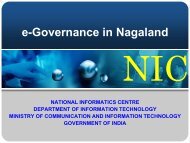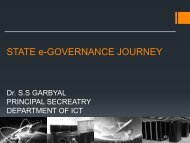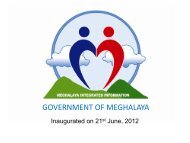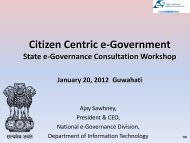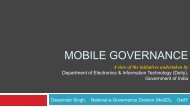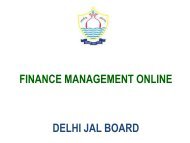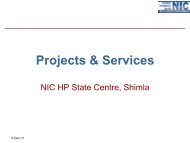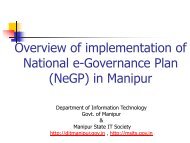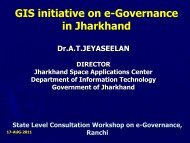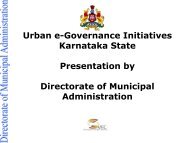Nemmadi Telecenter Project* - eGovReach
Nemmadi Telecenter Project* - eGovReach
Nemmadi Telecenter Project* - eGovReach
Create successful ePaper yourself
Turn your PDF publications into a flip-book with our unique Google optimized e-Paper software.
• VSAT network connecting the state data center to the <strong>Nemmadi</strong> back offices in<br />
each of the 177 talukas<br />
• c) <strong>Nemmadi</strong> telecenters<br />
• Departmental servers at the Taluka office<br />
I. State Data Centre (SDC) – Karnataka has been one of the first states to create a State<br />
Data Centre for both hosting all e-governance applications of the state and acting as a<br />
disaster recovery centre. The State data centre is the only means for delivery channels to<br />
connect to the departmental servers thereby isolating them from the various kinds of<br />
security threats that can take place if these departmental servers were directly connected<br />
to the Internet. II. VSAT Network – 203 distributed primary databases of bhoomi in the<br />
talukas replicate to the state data center every day to update the centralized bhoomi land<br />
records database at the state data center. This is accomplished through a VSAT network<br />
and an innovative customized replication mechanism due to many to one replication<br />
schema and limited bandwidth available. Each of the telecenters has a VSAT<br />
connectivity to VSAT hub and then a leased line connectivity from the hub to the state<br />
data center. This ensures an assured connectivity to the telecenters. III. Taluka Servers –<br />
The Taluka servers are both primary repository of data and additionally data updation due<br />
to many of the work flow processes for both Bhoomi and RDS services takes place at the<br />
Taluka server. While theoretically it is possible for users to connect to a central location<br />
(State Data Centre) however given the poor state of data connectivity from remote<br />
talukas of the state at the moment this is not practical. The above architecture of Taluka<br />
servers connected to the State Data centre has many advantages. Firstly the taluka servers<br />
can be remotely managed from a central location making trouble shooting, application<br />
management and deployment easy. Secondly external users can connect to the Taluka<br />
servers only through the SDC isolating the taluka servers from various security risks.<br />
Additionally the SDC also functions as a disaster recovery site for the taluka server. IV.<br />
<strong>Nemmadi</strong> Telecentres – Village telecentres are the nodes for the citizen to make requests<br />
and access various e-governance services. In most cases these village telecentres<br />
comprise of one or two computers with associated peripheral devices like printers,<br />
scanners, web cameras and they connect to the Internet through various dialup<br />
technologies. There are many challenges in establishment of village telecentres in terms<br />
of ownership of the village telecentres, operations of these telecentres, viability and<br />
service portfolio to be delivered through these village telecentres. Over the last 5 years,<br />
across the country, there has been a range of experimentation with regards to the<br />
ownership model of telecentres and it seems clear that these village telecentres can’t be<br />
owned or operated by government agencies and need to be privately owned and operated.<br />
Additionally these village telecentres need to deploy a range of both e-Governance and e-<br />
Commerce services to be financially viable. A corollary to this is that state governments<br />
need to increase the basket of e-governance services and not just deploy 1 or 2 services<br />
that can be delivered from the village telecentres so that village telecentres established by<br />
private entrepreneurs are financially viable. V. Taluka Back office – A back office at<br />
each of the taluka receives requests from the telecenters and processes it. The back office<br />
ensures each request has been field verified for correct data and generated the finl<br />
certificate which is digitally signed by the Tahsildar through his smart card. The<br />
certificates once signed queue up electronically at the telecenter for printing and delivery<br />
This chapter is re-produced with permission from the book “Transforming Government – eGovernment Initiatives in<br />
India, Editors: R K Bagga and Piyush Gupta, Published by : The ICFAI University Press, 2009


